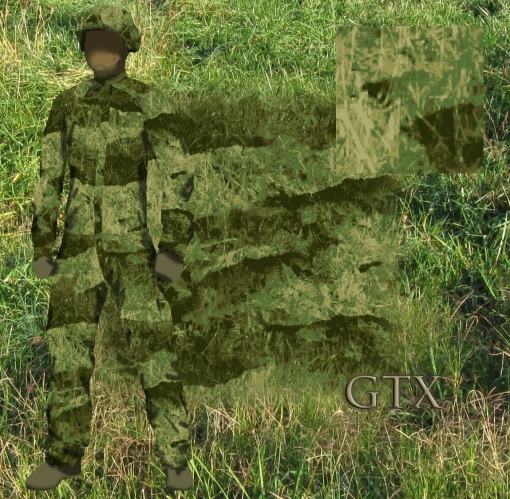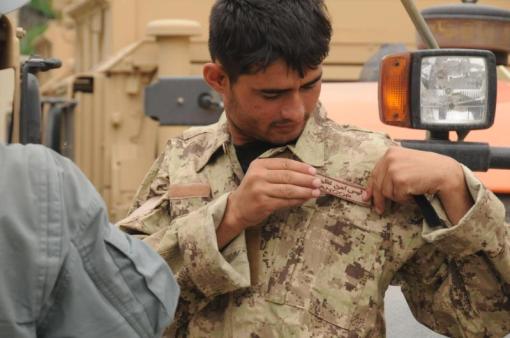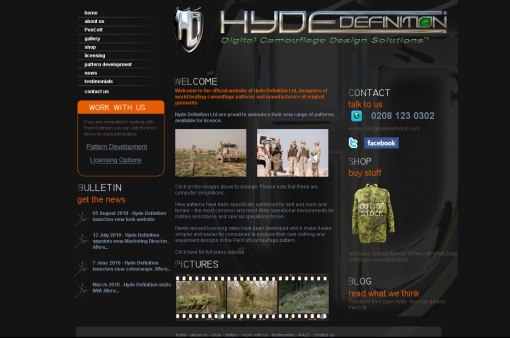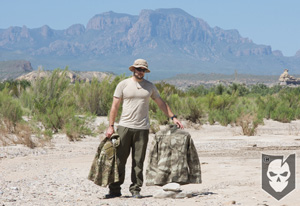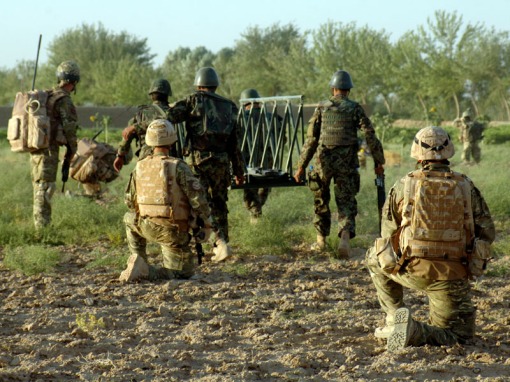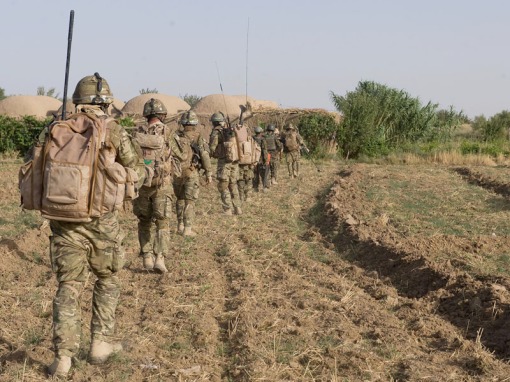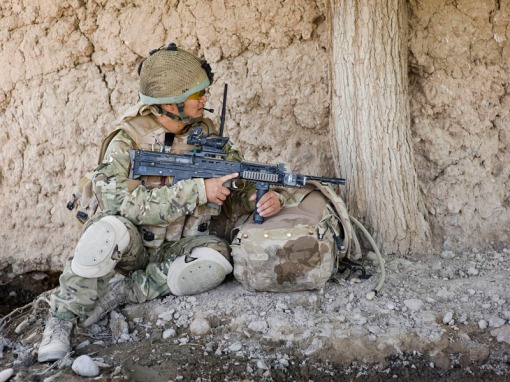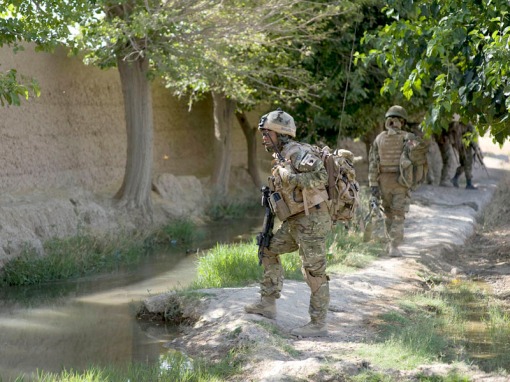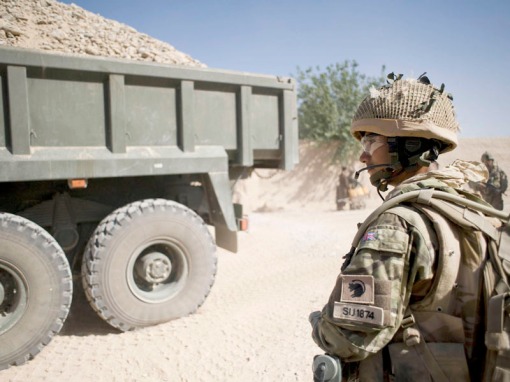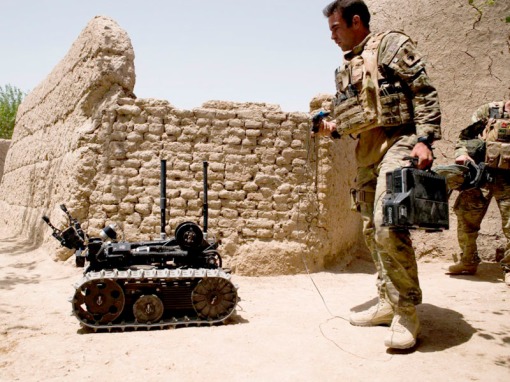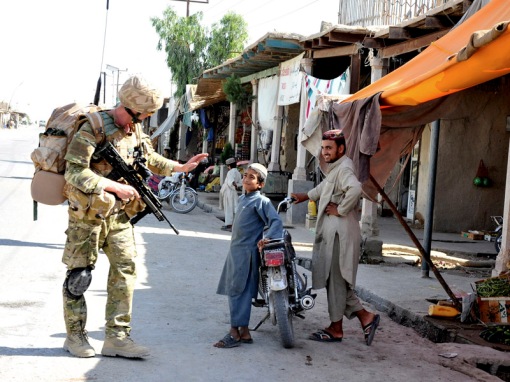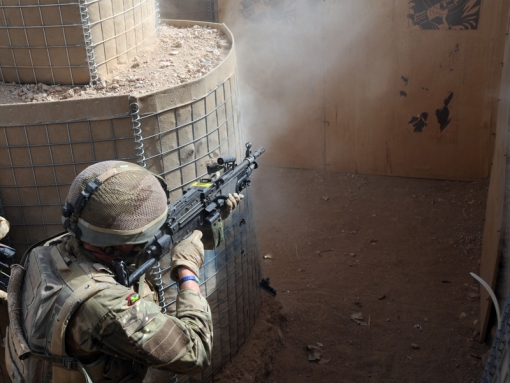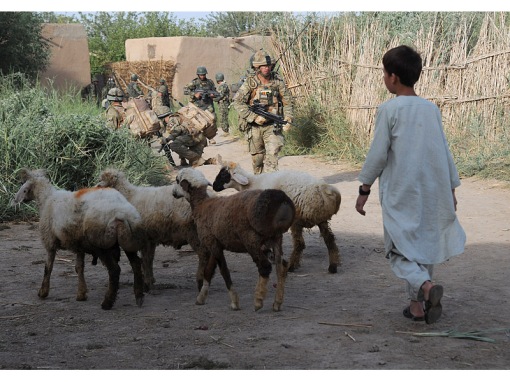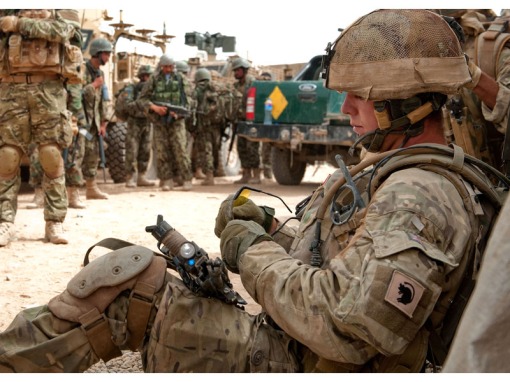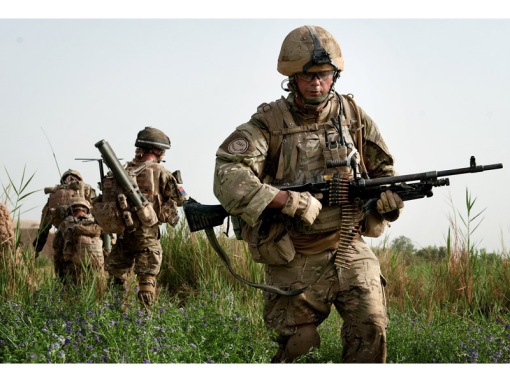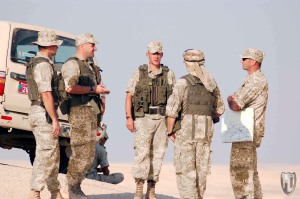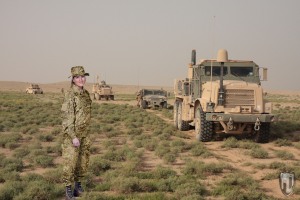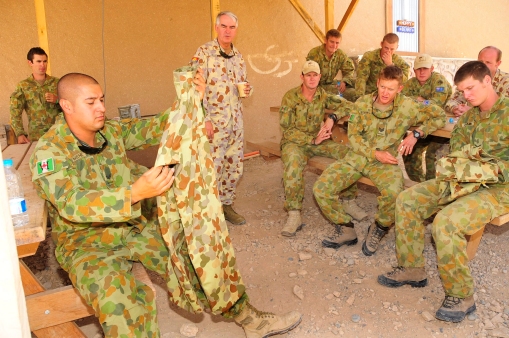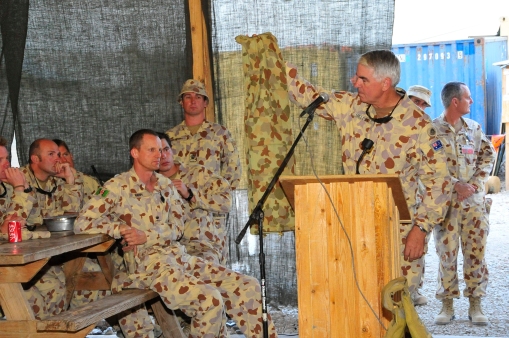Note the continued use of US 6 colour desert (“choc-chip”) camouflage mesh, seventeen years after it passed out of service in the US military! Also of note is the L22A2 carbine version of the standard British 5.56mm rifle, issued to vehicle crews.
image of the day
2 11 2010Comments : 2 Comments »
Tags: afghanistan, arid camo, british army, british camo, desert camouflage
Categories : british army, image of the day, weapons
multicam for usaf
18 09 2010…. well, for some of them anyway. The article below is reproduced courtesy of Strategy Page. All errors with reference to the ABU (Airman Battle Uniform) and UCP (Universal Camouflage Pattern) are theirs 😉
September 17, 2010: U.S. Air force personnel in Afghanistan have been buying (or scrounging from kindly army supply sergeants) the new MultiCam pattern uniforms. That’s because the air force uses a different camouflage pattern for their field uniforms, and when air force air controllers (who call in air strikes) move through the hills with army troops, it’s obvious from a distance who the air force personnel are. Actually, it makes all the troops more visible, because the MultiCam is pretty good at hiding those wearing it, but the difference between the air force camo and the MultiCam is so striking that the entire group of troops becomes more visible. The air force brass eventually got the message, and have started buying MultiCam uniforms for air force troops operating in combat along with army troops.
This was not the first problem of this sort. While the MultiCam was a an improvement on the older ACU pattern uniforms, the troops did not get new packs (which also use camo pattern cloth) at the same time they received the MultiCam uniforms. Thus when troops went off into the hills, the combination of MultiCam uniforms and ACU pattern packs do a lot to ruin the camouflage effect.
The U.S. military has been having a tough decade when it comes to camouflage uniforms. Since September 11, 2001, the U.S. Army has changed camouflage patterns for their combat uniforms twice. First it was the adoption of digital patterns, then the current move to MultiCam.
It was SOCOM (special operations command) troops who first had second thoughts about the older digital camo pattern. The digital camouflage pattern uses “pixels” (little square or round spots of color, like you will find on your computer monitor if you look very closely), instead of just splotches of different colors. Naturally, this was called “digital camouflage.” This pattern proved considerably more effective at hiding troops than older methods.
For example, in tests, it was found that soldiers wearing digital pattern uniforms were 50 percent more likely to escape detection by other troops, than if they were wearing standard green uniforms. What made the digital pattern work was the way the human brain processed information. The small “pixels” of color on the cloth makes the human brain see vegetation and terrain, not people. One could provide a more technical explanation, but the “brain processing” one pretty much says it all. Another advantage of the digital patterns is that they can also fool troops using night vision scopes. American troops are increasingly running up against opponents who have night optics, so wearing a camouflage pattern that looks like vegetation to someone with a night scope, is useful.
But digital doesn’t rule, at least not when price is no object. The runner-up in the competition was a non-digital pattern called MultiCam (cleverly designed to hide troops in many different environments). Many in the army preferred this one, but the difference, in tests, between it and the winner, digital ACU, was not that great. Moreover, MultiCam was about three times more expensive.
However, SOCOM operators have their own budget, and had many of their guys out in the field wearing MultiCam, rather than the digital ACU. Now SOCOM has always had a larger budget, per capita, than the rest of the army, and its operators had a lot of discretion to use whatever weapons or gear they thought best for the job. Apparently, on some jobs, MultiCam was considered more suitable than digital ACU. That said, there have been few complaints from soldiers about ACU, which measures up to MultiCam in most particulars, and it a lot cheaper.
Eventually, the services decided that if MultiCam provided even a small advantage over digital, than MultiCam was the way to go. The British Army thought the same thing, and are now sending new uniforms, using a version of MultiCam, to their troops. But for the new MultiCam to work, everything the troops wear has to be MultiCam. And everyone out with the troops, especially air force air controllers, need to be dressed in MultiCam as well.
Comments : 8 Comments »
Tags: ABU, ACU, afghanistan, arid camo, army combat uniform, camouflage news, crye, digital camo, mod, pixellated, UCP
Categories : ACU, afghanistan, british army, camouflage news, crye precision, MTP, multi-terrain pattern, multicam, universal camouflage pattern, war on terror
better camo on the web
7 08 2010My ICUS colleague Jon has launched a website for his new business ‘Better Camo’ whose stated aim is to
“achieve superior concealment through the use of large, environmental texture and color based, digitally designed camouflage patterns”
With two or three different textures on display, and having observed and absorbed the lessons learned by trailblazing companies like Hyde Definition, Better Camo looks set to add its distinctive look to the digital camouflage revolution.
You can check out the patterns yourself, and follow Jon’s blog or his twitter posts here: http://www.bettercamo.com/
We will be following their progress with interest and wish them every success for the future!
Comments : 1 Comment »
Tags: arid camo, camouflage design, camouflage news, desert camouflage, digital camo, snow camouflage
Categories : apparel, camouflage, camouflage design, camouflage news, clothing, environmental camouflage
new afghan pixellated pattern
6 08 2010My colleague Lawrence, over at Strike-Hold, picked up on some news out of Afghanistan which reveals that the Afghan National Civil Order Police are being kitted out in a desert coloured variant of Hyperstealth’s Spec4ce digital camouflage. The colours, while not the same, remind me of a mix between the old US 3 colour Desert Camouflage Uniform and Canada’s CADPAT Arid Regions.
The pale minty green background colour is not as out of place as one might think – from just a short distance away the hue fades to a greyish colour and the browner tones in the pattern dominate.
Comments : Leave a Comment »
Tags: afghanistan, arid camo, desert camouflage, digital camo, Hyperstealth, pixellated
Categories : afghanistan, camouflage, clothing
hyde definition’s new look
6 08 2010Hyde Definition, the digital camouflage and concealment company I run, has finally finished revamping its website. Well actually, not quite, as there are still one or two things that need adding and tidying, but to all intents and purposes it is done. Come on over and take a look!
Comments : Leave a Comment »
Tags: arid camo, british camo, camouflage design, camouflage news, concealment, custom camouflage, desert camouflage, digital camo, hyde definition, pencott, pixellated, snow camouflage
Categories : camouflage, camouflage design, camouflage news, graphic design, PenCott multi environment camouflage
camo comparison two
6 08 2010ITS Tactical, who did a terrific job photographing several different camouflage patterns in Oklahoma last year, have hit gold again with a repeat of the test, this time in Texas, and featuring a few more camouflage patterns (and a few less duds).
With half an eye on the current conflict in Afghanistan the team at ITS chose a mixture of terrain that included sand and rocks and some scrubby growth. Although the landscape favoured desert and semi-arid camo patterns, four woodland/temperate designs were featured in the tests too – MARPAT Woodland, Singapore Armed Forces (SAF) Digital, Jieitai (Japanese flecktarn) and PenCott. Judge for yourself, but of the four, I know which one I’d choose to wear in that sort of environment, if arid camo was not available 😉 Well, you would expect me to say that, wouldn’t you?
The test is very comprehensive, with consistent photos of all the camouflage patterns mounted on a dummy at set ranges in four different locales. You get a chance to pick up to four best performing patterns in each photo set. A tip regarding voting though – to be sure you are voting for the patterns you think are best, familiarise yourself with the designs – and the order they appear in – with one of the close range photo sets, because at long range it gets pretty hard to tell some of them apart, and the picture captions don’t give anything away!
Anyhow, you can check it all out on ITS Tactical’s blog
Comments : 1 Comment »
Tags: ACU, arid camo, army combat uniform, british camo, crye, desert camouflage, digital camo, hyde definition, pencott, pixellated, UCP
Categories : ACU, afghanistan, apparel, camouflage, clothing, concealment, crye precision, environmental camouflage, multicam, PenCott multi environment camouflage, UCP, universal camouflage pattern
mtp in action
22 07 2010Comments : 1 Comment »
Tags: afghanistan, arid camo, british army, british camo, desert camouflage, mod
Categories : afghanistan, army, british army, MTP, multi-terrain pattern
new multi-terrain camouflage patterns
7 06 2010Hyde Definition announces new PenCott™ multi-terrain camouflage patterns and revised licensing rates
New patterns have been specifically optimised for arid and semi-arid terrain – the most common and most likely operational environments for military assistance and special operations forces.
Newly revised licensing rates have been developed which make it even simpler and easier for companies to produce their own clothing and equipment designs in the PenCott camouflage pattern.
7 June 2010 – Hyde Definition Ltd. announces the release of two new multi-terrain camouflage colourways based on the proven PenCott multi-environment camouflage pattern. The new semi-arid environment “PenCott-Badlands” and arid environment “PenCott-Sandstorm” patterns have been specifically created to provide superior camouflage, and thus a tactical edge, for personnel operating in these environments.
Arid and semi-arid regions cover more than a third of the earth’s land mass and pose a distinct set of challenges to military forces – and especially camouflage designers. These regions are also the locations of the majority of armed conflicts that account for 1,000 deaths per year or more. These types of terrain therefore represent a very real operational requirement for uniforms and equipment optimised for use in these challenging environments.
The PenCott Multi-Environment Camouflage pattern uses a unique, digitally-enhanced mixture of blending and disrupting techniques, and has been specifically designed to:
- conceal more effectively at all typical engagement distances
- conceal more effectively at much closer distances than other patterns
- conceal more effectively in multiple environments and terrains
- dramatic improvement in concealment over previous generation patterns
Effective camouflage defeats the ability of the observer to detect or recognise the wearer as something of interest. But typical disruptive pattern camouflage can sometimes weaken the effect by introducing colours or shapes that look alien to a particular environment.
PenCott’s unique digital fractal design dithers four terrain-optimised contrasting colours – creating a combination of soft, blended and hard edges for a more natural-looking texture, and the illusion of a wider spectrum of colour tones.
The complex PenCott pattern is harder for the human eye to process, and recognisable shapes such as limbs and head-gear – or the lines of pocket edges – become more difficult to detect and recognise. PenCott disguises the wearer so effectively that he or she appears to literally melt in to the terrain.
The original PenCott-GreenZone pattern rapidly established a reputation of being “probably the best temperate/tropical terrain camouflage pattern in the world” (to paraphrase the famous beer adverts). Now the release of the “Badlands” and “Sandstorm” colourways means that special operations forces can enhance their tactical edge in those regions where they’re most likely to be deployed.
The new simpler, easier, revised scale of licensing fees makes it even easier for companies to produce their own clothing and equipment designs in the PenCott camouflage pattern. For further information, contact: dom@hydedefinition.com
About Hyde Definition
Headquartered in East Anglia in the UK, Hyde Definition has a young, loyal and dedicated team who strive to deliver cutting edge concealment solutions for personnel, materiel, vehicles and buildings.
Founded in 2007, the company undertakes camouflage design commissions and licensing agreements worldwide.
Visit the website www.hydedefinition.com
Comments : 9 Comments »
Tags: arid camo, british camo, camouflage news, desert camouflage, digital camo, hyde definition, pencott, pixellated
Categories : apparel, camouflage, camouflage news, clothing, environmental camouflage, multi-terrain pattern, PenCott multi environment camouflage
new australian camo to be trialled
25 05 2010New photos on the Australian Department of Defence (DoD) website show a variation of their armed forces’ iconic ‘bunny’ or ‘jelly bean’ Disruptive Pattern Uniform (DPU). The colourway looks to be optimised for semi-arid regions like Afghanistan, and according to a source at the International Camouflage Uniform Society
The Defence Science and Technology Organisation (DSTO) developed a mid point colour set that may better meet the range of environments that deployed troops are encountering, particularly within Afghanistan.
In December 2009, the Chief of Army directed an in-theatre trial of the new pattern to confirm its effectiveness. This uniform is referred to as Disruptive Pattern Mid-Point Uniform (DPMU). Subject to the successful outcome of the Australian and in-theatre trials, Army intends to roll the DPMU uniform out to deployed troops as quickly as possible.
The picture above (photo by SGT Brent Tero) illustrates the desert (DPDU) and standard colourways alongside the new Mid-Point variaton.
Here is a clearer view of the colours (photo by SGT Brent Tero). Visit the Australian DoD web gallery for Operation Slipper to see more.
Comments : 8 Comments »
Tags: afghanistan, arid camo, australian camo, camouflage news, desert camouflage, dpdu, dpmu, dpu
Categories : afghanistan
image of the day
21 05 2010Image of the Day: 21 May 2010
Comments : Leave a Comment »
Tags: afghanistan, arid camo, british army, british camo, crye, desert camouflage, digital camo, marpat, mod, pixellated, united states marine corps, usmc
Categories : afghanistan, british army, crye precision, image of the day, MTP, multi-terrain pattern, multicam, war on terror


